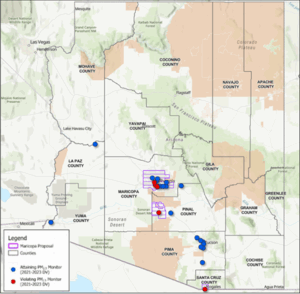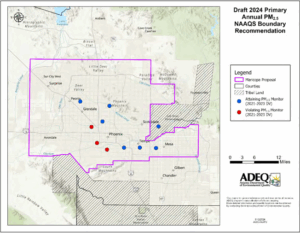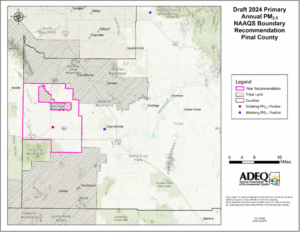On June 20, 2024, the Arizona Department of Environmental Quality (ADEQ) published initial draft nonattainment boundary recommendations for the new annual fine particulate matter (PM2.5) National Ambient Air Quality Standards (NAAQS) for Arizona. These determinations were made by ADEQ in response to the revision of the annual PM2.5 NAAQS from 12 μg/m3 to 9.0 μg/m3, finalized on February 7, 2024 by the Environmental Protection Agency (EPA), and made effective on May 6, 2024.
Initial Draft Recommendations
Clean Air Act (CAA) §107(d) requires that the EPA designate all parts of the country with respect to the revised standard. In accordance with CAA §107(d)(1) and Arizona Revised Statutes (A.R.S.) §49-405, the Arizona governor must submit to EPA initial state area designations as “attainment”, “nonattainment”, or “unclassifiable” no later than one (1) year after the promulgation of the NAAQS (i.e. February 7, 2024). A nonattainment area is any area that does not meet (or that contributes to ambient air quality in a nearby area that does not meet) the annual PM2.5 NAAQS. An attainment area is any area outside of a nonattainment area that meets the NAAQS. An unclassifiable area is any area that cannot be classified on the basis of available information as meeting or not meeting the NAAQS. It is anticipated that EPA area designations for the new annual PM2.5 NAAQS may occur on February 7, 2026 at the earliest.
A.R.S. § 49-405(C) requires ADEQ to support the governor in making determinations by preparing draft boundary designations and supporting documents for the entire state of Arizona, which must be published on the agency website between 4 and 5 months before they are due to the governor. As such, ADEQ is publishing draft determinations based on a review of available ambient 2021-2023 monitor concentration data and guidance, including EPA’s Initial Area Designations Memorandum (Designations Memo), which provides a framework for area-specific analyses based on five (5) factors: air quality data, emissions and emissions-related data, meteorology, geography/topography, and jurisdictional boundaries. The monitor data was used to determine the 2023 design values (i.e., the metrics compared against the NAAQS) for different areas in Arizona based on the annual arithmetic mean concentrations of PM2.5 for 2021-2023. Figure 1 shows the nonattainment areas have been proposed by ADEQ in the following Arizona counties: Maricopa, Pinal, and Santa Cruz. An interactive map is also available.
It must be noted that ADEQ elected to not proceed with the exclusion of impacts from exceptional events (i.e., unusual or naturally occurring events that can affect air quality), as these events were stated to not affect attainment status based on data for 2020 through 2023.
Figure 1. Initial Proposed Nonattainment Areas in Arizona

Proposed Maricopa County Recommended Nonattainment Area
ADEQ recommended a nonattainment area that encompasses a portion of Maricopa County, referred to as the Mesa Metropolitan Statistical Area (MSA), including the three violating monitors (Durango Complex, West Phoenix, and South Phoenix Monitors) and areas that are likely to contribute to those violations. Figure 2 below shows the recommended boundary, which is significantly smaller than the current serious nonattainment area for particulate matter with a diameter of 10 microns or less (PM10). It must be noted that the Phoenix-Chandler Mesa MSA does not include the Gilbert and Chandler areas. Additionally, unlike the serious PM10 nonattainment area, the Phoenix-Chandler Mesa MSA does not include Native American land.
Overall, most monitors in Maricopa County have been trending downward, which would benefit the area towards achieving attainment with the NAAQS in the future.
Figure 2. Maricopa County Proposed Nonattainment Area

Pinal County Recommended Nonattainment Area
ADEQ recommended a nonattainment area in West Pinal County, shown in Figure 3, that is contingent on EPA’s determination of whether the Hidden Valley monitor site (operational since 2016, former location was the Cowtown Road site) is ineligible for comparison to the annual NAAQS. The Hidden Valley monitor is the only monitor in the County network to show a violation of the NAAQS. The proposed nonattainment area boundary would be significantly smaller than the current West Pinal County PM10 nonattainment area boundary, which also includes portions of the county such as Eloy and Casa Grande, where industrial growth has been observed in the recent years. It must be noted that if EPA determines that the Hidden Valley PM2.5 monitor is ineligible for comparison to the NAAQS, then ADEQ recommends that the area be designated as unclassifiable due to a lack of available information to accurately classify the area.
Figure 3. Pinal County Proposed Nonattainment Area

Nogales Recommended Nonattainment Area
ADEQ recommended that the 2024 annual PM2.5 Santa Cruz County nonattainment area boundary retain the existing 2006 24-hour PM2.5 NAAQS Nogales, AZ maintenance area boundary. This recommended boundary also aligns with the existing PM10 nonattainment area. There is only one monitor used for the Santa Cruz County determination which is the Nogales Post Office monitor.
Next Steps
ADEQ will be hosting information sessions this July in the different counties with proposed 2024 annual PM2.5 nonattainment areas to provide an initial opportunity for stakeholders to ask questions and/or provide informal feedback. Those interested in attending may register here. ADEQ anticipates holding a formal public comment period on the proposed PM2.5 boundary recommendation in the fall of 2024.
If you have questions about the initial draft nonattainment boundary recommendations for the new annual PM2.5 NAAQS and how it may impact your facility or if you are interested in situating a new facility within the proposed area, please email Camille Maradiaga in Trinity’s Phoenix office.

